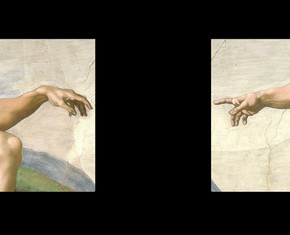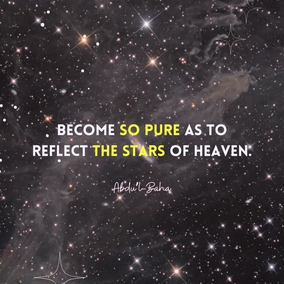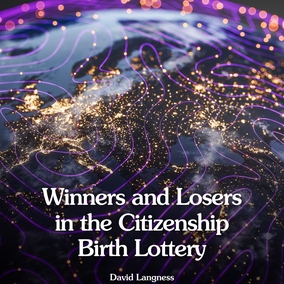The views expressed in our content reflect individual perspectives and do not represent the authoritative views of the Baha'i Faith.
The old world of classical or Newtonian physics presented us with a universe that could be described as working like clockwork in its behavior—but the universe turned out to be much more complex.
The Baha’i teachings allude to this enormous complexity, and attribute it to the creative powers of God:
All praise to the unity of God, and all honor to Him, the sovereign Lord, the incomparable and all-glorious Ruler of the universe, Who, out of utter nothingness, hath created the reality of all things, Who, from naught, hath brought into being the most refined and subtle elements of His creation, and Who, rescuing His creatures from the abasement of remoteness and the perils of ultimate extinction, hath received them into His kingdom of incorruptible glory. Nothing short of His all-encompassing grace, His all-pervading mercy, could have possibly achieved it. How could it, otherwise, have been possible for sheer nothingness to have acquired by itself the worthiness and capacity to emerge from its state of non-existence into the realm of being? – Baha’u’llah, Gleanings from the Writings of Baha’u’llah, pp. 64-65.
Modern science, especially with the discovery of quantum mechanics, has vastly increased our knowledge of the mind-boggling complexity of this creation.
For Newton, each part of the observable universe interacted with the other parts according to deterministic, inviolable laws. Like they do on a billiard table, classical physics will tell you that the balls follow predictable trajectories prescribed by simple mechanical laws. The balls all follow a straight path until they collide with another ball or the side cushion. Balls in motion stay in motion, assuming the table is flat and there is no friction. A ball at rest stays at rest unless acted upon by another ball or force, and so on.
The analogy continued at the atomic level, with each atom in the universe acting predictably, like a tiny billiard ball interacting with other billiard balls. The rules of this interaction are a bit more complicated than those of billiard balls, but work well for the overall analogy. Scientists believed they could, in theory, predict the entire history of the universe by knowing the initial positions and velocities of each particle at the very beginning. By knowing the initial state of a closed system, scientists believed they could determine with 100% accuracy its state at some future time. The only uncertainty comes from the inability to exactly know its initial state.
Many have used this classical view of the universe to support the non-existence of miracles and the supposed impossibility of divine intervention. This argument, however, ultimately hinges on whether or not the universe is in fact a closed system. Regardless, during the last 90 years, Newton’s classic mechanical view of the universe has given way to special relativity, general relativity, and quantum mechanics.
The discovery of quantum mechanics forced several substantial departures from classical physics. Even though most of the observable universe is measureable and governed by predictable laws, scientists realized, behind everything a world of tiny sub-atomic particles exists—and they exhibit totally random, unpredictable behavior. Quantum mechanics gave birth to the Heisenberg uncertainty principle, which states that it is impossible to know both the velocity and position of a particle at the same time.
Despite our advanced science, which can measure sub-atomic particles with sufficient precision, the Heisenberg principle asserts the impossibility of doing so, no matter how advanced our technology. Even if you know the position of a particle with infinite precision, measurement of its momentum gives a completely random result—and vice versa. So in quantum mechanics nothing can be certain, and you can only describe things in terms of probabilities.
Albert Einstein, however, struggled with the uncertainty principle. He believed that there had to be some law of nature that could define particles and make it possible to calculate their velocity and position. This caused Dr. Einstein to utter his famous quote: “God does not play dice with the universe.”
Einstein spent the rest of his career searching, but found no conclusive evidence of the law he hoped for. So far, all experimental evidence suggests that quantum mechanics is real, and the uncertainty principle has held true.
So what does this discussion have to do with miracles and answered prayers?
In simple terms, quantum mechanics says that physical laws, even the classical laws of mechanics, are determined by probability. Classical particles take only a single predictable path, while quantum particles take all paths simultaneously—an infinity of quantum-mechanically possible trajectories. Normal paths that we associate with classical mechanics are likely to occur, while bizarre paths are not very likely to occur. Nonetheless, all paths are taken regardless of their likelihood. The probability of any non-classical path might be extremely low, but not zero.
Classical physics allowed the materialist and the Newtonian scientist to assert that certain events were simply “impossible under the laws of physics.” Quantum mechanics excludes such an assertion. Now we can only say that an event, according to the laws of physics, “is highly unlikely, but not impossible.”
A world of differences exists between impossible and unlikely. With this scientific truth in mind, the Baha’i teachings confirm that:
There is no contradiction between true religion and science. When a religion is opposed to science it becomes mere superstition: that which is contrary to knowledge is ignorance.
How can a man believe to be a fact that which science has proved to be impossible? If he believes in spite of his reason, it is rather ignorant superstition than faith. The true principles of all religions are in conformity with the teachings of science. – Abdu’l-Baha, Paris Talks, p. 141.
This new image—the image of reality presented to us by quantum mechanics—changes our entire view of the known universe. That new scientific knowledge makes it clear that divine actions are compatible with science. Quantum mechanics means that even the most amazing miracles do not clearly contradict the laws proclaimed by science, at least as we currently understand them.
You May Also Like
Comments

















― David Bohm
This faculty of meditation frees man from the animal nature, discerns the reality of things, puts man in touch with God.
This faculty brings forth from the invisible plane the sciences and arts. Through the meditative faculty inventions are made possible, colossal undertakings are carried out; through it governments can run smoothly. Through this faculty man enters into the very Kingdom of God.
Abdu’l-Baha, Paris Talks, p184 [2 of 3]